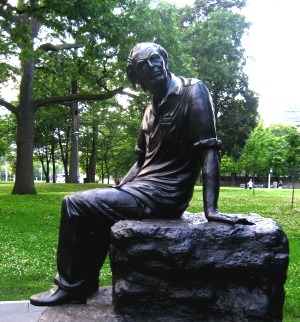Canadian poet Al Purdy visited Lake Chapala more than once in the late 1970s. Purdy spent more than a month in Ajijic over the winter of 1978-79 and later had a short travel piece entitled “Let There Be Light – Perhaps” accepted by Leisureways.
The quotes incorporated in the following summary of that piece come from the manuscript version of the article in the Purdy archives at Queen’s University in London, Ontario.

Statue of Purdy in Queen’s Park, Toronto. Photo: Marisa Burton.
Purdy thought that Chapala was “a sprawling untidy settlement,” where “a real estate boom, perhaps twenty years ago,” followed by a bust had left “half—built houses on the outskirts and red brick streets running nowhere.” Purdy summed the town up as “half ghost town and half a hive of geriatric tourists and the native Mexicans.”
As for the tourists, they were “mostly very old” and had “made their pile in New York or wherever when they were younger, and now come here to play bridge, soak up the sun and live the good life, wading thru sunshine instead of snow.”
Purdy wanted to soak his “arthritic knee in hot springs at San Juan Cosala then take off for places the tourists haven’t found yet.” They had trouble finding living quarters for a month “in an area that is completely jammed.”
Hank Edwards, a painter friend who had built a house in Ajijic, suggested they visit “La Russe” (Zara) because he had heard that her lakeside cottage was unoccupied. However, a meeting to “Save the Lake” was in progress on Zara’s patio, preparing the text of a telegram to send to the state governor protesting the dire situation of the lake. The following day, Purdy and his wife viewed the cottage only to discover that it was “a pretty crummy joint.” They were eventually able to “rent a small apartment on the mountain slope above Ajijic.”
During their time in Ajijic, Purdy viewed the D. H. Lawrence house in Chapala – “a sprawl of brick and stucco mansion, complete with falling plaster” – on the market at that time for $75,000.
Not surprisingly, given that it was more than fifty years since Lawrence had been there, Purdy was unable to find any trace of Lawrence in the building, but enjoyed letting his imagination picture the author in the building: “… there is a wrought iron spiral staircase, ending at upstairs bedrooms, that I’m sure Lawrence must have climbed; and an immense glass chandelier glittering its thousand suns in the living room, and which at one time must have reflected Lawrence’s own blue eyes.”
Actually, the house had only a single story when Lawrence rented it and the deficient electricity supply at the time would have necessitated candles in the chandelier.
Lunching at the Posada Ajijic, Purdy and his wife chatted to a pair of elderly American ladies who knew La Russe and recounted stories of her dance career (in Europe and elsewhere), her “brother”, and Zara’s attempt to star in a ballet she had written.
Purdy commented on the great Mexican muralists, Orozco and Rivera, and how the “cultured English novelists, Graham Greene, Evelyn Waugh and Aldous Huxley” who had visited Mexico, all “hated the place”, before turning his attention to how “D.H. Lawrence was alternately fascinated and repelled by Mexico with its basically Indian population, whose tradition of blood stretches back to the Aztecs and long before. Mayan and Aztec gods were deities of violence and death, the dark side of life.”
Despite the roads, roadkill, police, and the sketchy electricity supply, Purdy loved Mexico.
Prefacing a conversation he overheard while soaking in the mineral baths of San Juan Cosalá, Purdy described the scene in lively prose: “The white Aztec sun blazed down; brilliant red and purple flowers trembled on the fringes of vision; the blue lake was incandescent in its multiple reflections. Human bodies of all sizes, sexes and degrees of fatness lounged in and around the several pools, their temperatures graduated according to personal inclination.”
The hills were dormant in the winter dry season but on the “luxuriant green” lakeshore, “Mexican kids play their game in the dust, gabbing together; fat mothers feed their babies, thin mothers feed their babies; old men totter thru the cobbled streets, a flash of their eyes responding to friends’ flash of their eyes in greeting.”
Purdy was an astute, sensitive observer of Mexico and it is Lake Chapala’s gain that this great Canadian poet chose to follow in the footsteps of D. H. Lawrence and spend some time here.
Note
All quotes come from the manuscript version of “Let There Be Light – Perhaps” in the Queen’s University Purdy Archive (CA ON00239 F02017-S06-f0003 – “Article on Chapala, Mexico accepted for Leisureways Magazine”). I have so far failed to locate any published version of this article, accepted by Leisureways (according to Purdy’s notes) in about 1979-1980. The first edition of Leisureways was published by the Ontario Motor League in 1981. It is likely that Purdy’s article actually appeared in the final (1980-81) volume of Canadian Motorist, the publication’s name prior to its rebranding.
Acknowledgment
I am very grateful to Queen’s University archivist Heather Home and her administrative assistant, Lisa Gervais, for their help in supplying copies of materials from the university’s Purdy Archive.
Comments, corrections or additional material related to any of the writers and artists featured in this series of mini-bios are welcome. Please email us or use the comments feature at the bottom of individual posts.
Tony Burton’s books include “Lake Chapala: A Postcard History” (2022), “Foreign Footprints in Ajijic” (2022), “If Walls Could Talk: Chapala’s historic buildings and their former occupants” (2020), (available in translation as “Si Las Paredes Hablaran”), “Mexican Kaleidoscope” (2016), and “Lake Chapala Through the Ages” (2008).